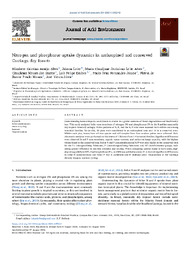Nitrogen and phosphorus uptake dynamics in anthropized and conserved Caatinga dry forests.
Nitrogen and phosphorus uptake dynamics in anthropized and conserved Caatinga dry forests.
Author(s): SILVA, E. C. A.; LEITE, J.; ALVES, M. C. J. L.; SANTOS, C. M. dos; DAIBES, L. F.; FERNANDES JUNIOR, P. I.; MOURA, F. de B. P.; SILVA, J. V. da
Summary: Understanding human impacts on drylands is crucial in a global scenario of forest degradation and biodiversity loss. This study analyzed foliar concentrations of nitrogen (N) and phosphorous (P) in the Brazilian seasonally dry tropical forests (Caatinga). Foliar patterns of N, P, and the N/P ratio were assessed both within and among botanical families. To do this, 10 plots were established in an anthropized area and 10 in a conserved area. Within each plot, leaves from all tree species and soil samples from four random points were collected. Stoi-chiometric analyses were performed on the leaves of 136 trees from 14 botanical families. Significant differences were observed in soil P concentrations, organic matter content, and cation exchange capacity, with the highest values found in the conserved area. Foliar N and P concentrations and N/P were also higher in the conserved area for the F+ (nitrogen-fixing Fabaceae), F- (non-nitrogen-fixing Fabaceae), and NF (non-Fabaceae) groups, indicating greater efficiency in nutrient retention and cycling. When comparing species found in both areas, Aspidosperma pyrifolium (NF), Bauhinia forficata (F-), and Mimosa ophthalmocentra (F+) showed significant differences in foliar N concentrations and foliar P (for A. pyrifolium and B. forficata only). Degradation of the Caatinga directly impacts nutrient cycling.
Publication year: 2024
Types of publication: Journal article
Unit: Embrapa Semi-arid Region
Keywords: Absorção de nitrogênio, Caatinga, Caatinga antropizadas e conservadas, Carbono, Ciclagem de nutrientes, Degradação Ambiental, Degradação da Caatinga, Degradação florestal, Dryland farming, Espécie Nativa, Estequiometria foliar, Fixação de Nitrogênio, Floresta, Floresta Tropical, Florestas secas, Forests, Fósforo, Manejo de Caatinga, Nitrogen fixation, Nitrogênio, Semiárido, Terra seca tropical, Terra árida, Tropical forests
Observation
Some of Embrapa's publications are published as ePub files. To read them, use or download one of the following free software options to your computer or mobile device. Android: Google Play Books; IOS: iBooks; Windows and Linux: Calibre.
Access other publications
Access the Agricultural Research Database (BDPA) to consult Embrapa's full library collection and records.
Visit Embrapa Bookstore to purchase books and other publications sold by Embrapa.

